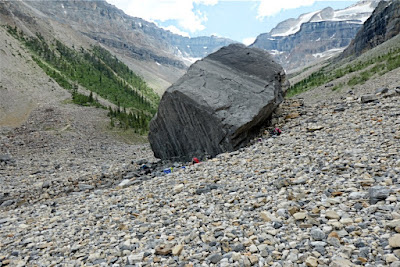the canyon became deeper and narrower, and the water faster.Sometimes it looked as if a giant axe had split the rocks.
The varying depths and angles created different lighting, including the occasional rainbow.Some folks enjoyed going beyond the fences.
After this hike, Joan and I decided to return to Storm Mountain and spent the afternoon resting or taking local walks. It was our last night there, and we settled on tomorrow's goal: a trip to Wapta Falls before turning around and motoring east to Moraine Lake Lodge.
The next day, July 24th, we set out for Wapta. When traveling westbound, as we were, the route is tricky. One must leave the Trans-Canada on a small side road, pass under the highway, and proceed down a gravel route to the trailhead. As Joan and I approached the critical area, there were construction signs, and workers milling about. We missed the turnoff, and the next chance to turn around wasn't until a rest area much further down the Trans-Canada. Click on the image to enlarge -- Google Maps estimates we spent at least an hour and a half on the road. Whew!
A gentle but obscure switchback reaches the bottom of the falls, but many visitors either didn't see it or preferred to plummet down a steep slope without handholds to reach the bottom. Joan and I took the steep way down, where there were gravel beaches to wander on and logs to sit on while eating lunch.
As an exploratory gamble, on our return we began with the switchback, and found it deserted and congenial all the way back to the top of the falls, where we retraced our steps to the car.
After a few miles, the traffic came to a stop. There was no sign of an accident, but some people had left their vehicles to wander about and catch the air. Then we began to inch forward. Turning around was not an option; we would have had to drive around half the province (a mild exaggeration). There are precious few routes through the Rockies and the continental divide.
The creeping grew progressively better, but it was still creeping. We wondered, had there been an accident, or, given the volume of traffic on a sunny Sunday on a two-lane road, were we beyond the carrying capacity of the highway? I thought of the climb up Kicking Horse Pass; even one semi-truck struggling up that incline would reduce the volume by half!
Fortunately, the congestion let up as we squeezed through Field. But our goal, Moraine Lake Lodge, lies in a permanently congested area it shares with Lake Louise. This summer (2022), private vehicles were turned around from the 19-mile road to Moraine Lake after 4am: you had to book a shuttle. But, as Lodge guests, our exalted status took us past the traffic guards and their orange-and-white sawhorses -- after driving to and from the Lake Louise parking, for left turns onto the Moraine Lake road are not allowed.
What a day! But now we were at Moraine Lake, and ready to indulge in some serious hiking on the morrow.





































